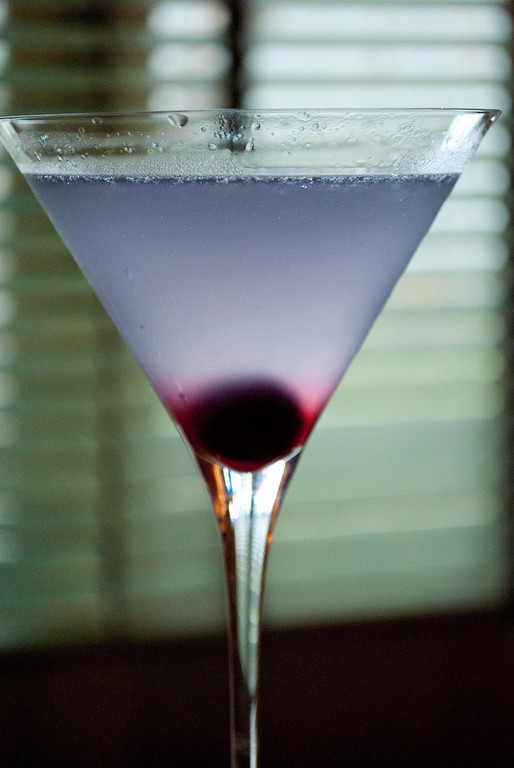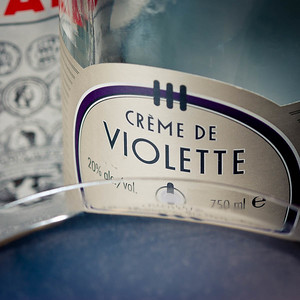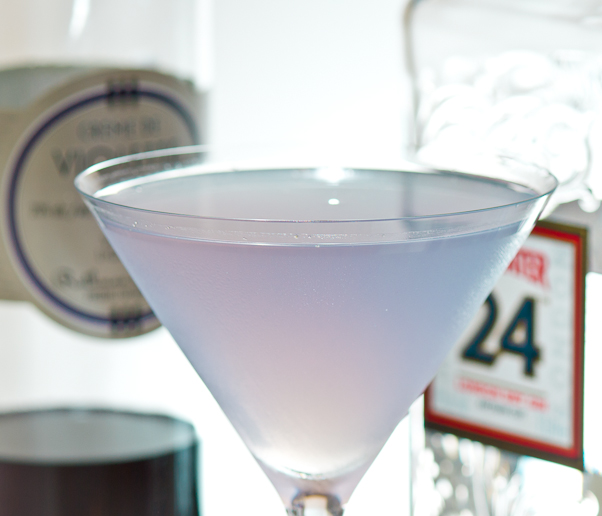The history of the Aviation Cocktail is a tale of neglect and abuse, rehabilitation and redemption, and even controversy. Sort of like Cinderella with politics. I love these cocktails with stories.
The Aviation has been around at least since 1911, according to David Wondrich’s Imbibe! It has been flying well under the radar ever since. Or at least ever since there was radar.
Its obscurity seems a combination of bad luck and an uncommon-ingredients recipe. Hugo Ensslin first published the formula for the Aviation in his 1916 Recipes for Mixed Drinks, combining two parts gin, one part lemon juice, and two dashes each of maraschino and crème de violette liqueurs. I haven’t been able to determine if both liqueurs would have been commonly stocked in bars, either pre- or post-Prohibition; it seems unlikely they would be in the average home bartender’s standard inventory, since there are relatively few applications for them. As wildly popular as aviation, the sport, seems to have been, there is no indication that Aviation, the cocktail, was the fashionable drink of its day.
The bad luck part came along in 1930, when the widely referenced Savoy Cocktail Book dropped the crème de violette from the drink’s recipe. The Aviation Cocktail was transformed in that typo-driven instant into a strongly sour drink, with an aggressive dollop of lemon juice and the assertive maraschino liqueur. The charming blue hue that suggested its name was gone. A very tough sell, it was doomed to languish, as bar books ever since have provided iterations of the violette-free Aviation, each one struggling with the sweet-sour balance and the robust nature of maraschino. Crème de violette, its use increasingly arcane, finally disappeared from the United States in the 1960s.

The poor, benighted Aviation was released from cocktail trivia prison in 2007 when the very floral Rothman and Winter crème de violette reappeared in the US market, and the renewed possibility of making the Aviation along the lines of the original Ensslin recipe caught the fancy of the growing body of history-minded cocktailians. In short order, the blogosphere elevated the Aviation to fashionable prominence.
And controversy. There is a school of thought that says that if crème de violette is available, the drink certainly should be made with crème de violette. There is another faction that declares the currently available crème de V “not good enough,” and they’ll stick with the well-published, long standard violette-free version, thank you very much.
Thus, the arrival of crème de violette has made the Aviation the centerpiece of a robust, larger conversation about whether cocktail recipes, especially the first publication recipes, should be considered law, or merely guidelines; and to what extent it’s reasonable to change proportions, to add, subtract, or substitute ingredients, or even change the size of the pour, before the drink takes on such a different character that it becomes a different product altogether. Can a cocktail properly evolve beyond its original definition? Or, as it loses its fidelity to the “original,” must it be considered an entirely different cocktail, signified at the very least by a different name?
I’m not ready to support either side in this controversy. As for how much you can change a cocktail before it loses its identity, I’m afraid I’m in the same position where Supreme Court Justice Potter Stewart famously found himself when considering a completely different topic—I can’t describe when it’s gone too far, but I know it when I see it.
 So I’ll stick to the very narrow position that there seems little point in making an Aviation without crème de violette. Without it, the drink is (a) not charmingly blue; and (b) not deliciously, memorably tasty.
So I’ll stick to the very narrow position that there seems little point in making an Aviation without crème de violette. Without it, the drink is (a) not charmingly blue; and (b) not deliciously, memorably tasty.
The violette adds to the nose, and brings additional sweetness and a depth of flavor to the drink. I do believe that a healthy proportion of lemon helps the drink, and experimentation has brought me around to the idea that it should be small, very cold, and emphatically sour. Not 2:1 sour, but noticably and bracingly sour. So here is the Cold Glass Aviation:
The Aviation Cocktail
- 2 oz London Dry gin (Plymouth or Bombay Dry)
- ½–¾ oz fresh lemon juice
- ¼ oz maraschino liqueur (Luxardo)
- ¼ oz crème de violette (Rothman & Winter)
Shake with ice, strain into a well-chilled cocktail glass. Garnish with brandied cherry.
The ¾-ounce portion of lemon juice is the “hot days” version, a bit more sour and brightly refreshing on sticky summer evenings. Lemons are highly variable, so as you experiment with the proportions, you may want to work in a little simple syrup to balance the flavors without overloading the liqueurs; maraschino and violette can be overbearing, and I’ve found that these relatively small amounts—less than you’d find in many published versions of the drink—work well for both flavor and color. (I haven’t found a drink yet that is improved by adding more than ¼ ounce of Luxardo, it’s fairly strong.)
Some of the citrusy gins make a fun variant in this cocktail, especially if you want to try upping the lemon nose and flavor without pushing up the sourness. I’ve used New Amsterdam and Bombay Sapphire with good results, but there are many to play with.
Failed Substitutions Department: I tried making Aviations with cheap maraschino liqueur. They were very, very bad; don’t go there. Luxardo is pretty much a quality standard, available everywhere, and the extra cost represents the difference between cocktails and dreck.
Even Bigger Failed Substitutions Department: A bartender with no crème de violette served me an Aviation that substituted blue curaçao. It was strikingly, garishly blue. It did not taste good. I won’t be doing that again.
“Aviation Cocktail” at cold-glass.com : All text and photos copyright © 2010 Douglas M. Ford. All rights reserved.

There are “relatively few applications” for Maraschino? That’s not true at all. It’s an integral ingredient in tons of cocktails, from pre-prohibition like this one and the Martinez, to lots of awesome modern ones, like The Red Hook…
Hi, Rhett, thanks for the comment, it really goes to the heart of the article.
You’re right to point out that there are many cocktails that call for Maraschino. I’ve come to enjoy Maraschino over time, much more than I did when I wrote this article, enough to search out recipes that include it. My remark about never using more than a quarter ounce is amusing in retrospect; I’ll just write that off to the learning curve, developing a taste for the stuff.
The question I pondered as I wrote this article was the likelihood that a home bar in the first decades of the 20th century would include Maraschino, or just the more commonly requested basic additives like vermouth, curacao or triple sec, bitters, perhaps grenadine. It’s pure speculation—I have no idea where one would even start looking for stats on the subject—but speculation based on the marginalization of both Maraschino and Violette, and finally the complete disappearance altogether of the Violette. At least Maraschino had enough going for it that it stayed on the shelves; poor Violette, with even fewer recipes to prop it up, the marketplace just didn’t support it.
I’ll say one thing: I’m delighted that there are finally enough people with the interest and awareness, like yourself, to support these products and bring them some prominence and market viability again.
I’m with you on all points! Wouldn’t it be great to see detailed inventories of home and professional bars from the time? :)
It’s interesting I stumbled across this today, I just started a month-long focus entirely on Maraschino on my blog…
http://www.and1morefortheroad.blogspot.com/2012/03/maraschino-march.html
Thanks for the reply!
Hi Doug,
Don’t you love it when years after you write a post it suddenly comes back to life?
The Aviation is a great favorite of mine. So I’d like to present a different point of view on its last decades.
I started getting serious about cocktails in May of 2002. At that time the Aviation (gin, maraschino, lemon) was “the secret handshake” of the cocktail set – if you knew what the Aviation was, you were ‘in the know’. I believe Dale DeGroff brought it back from obscurity, but it might be Paul Harrington who made it famous in his 1998 book “Cocktail, a Drinks Manual for the 21rst Century” and in his cocktail column on Wired.com [which may have actually been the first cocktail “blog”], and because he was serving them to the dot com crowd in Emeryville, CA.
The “yellow” Aviation (1.5 gin, .75 lemon, .5 maraschino) was a smash hit – in my life making instant believers out of cocktail skeptics. Luxardo Maraschino is great stuff, but easily overpowering and must be strictly measured or you will wind up with what Harrington termed ‘a glass of pixie stix’
When the first edition of Ted Haigh’s Vintage Spirits and Forgotten Cocktails came out in 2004, he mentioned that as great as the Aviation was, he had had a ‘Blue Moon’ (an Aviation plus Crème de Violette) which was better. We all waited until 2008 when Rothman and Winter re-introduced Crème De Violette to the US, and by then there were lots of reprints of cocktail books and we all had Ensslin’s recipe in our hands. Here is Gary Regan’s take on that moment – http://www.sfgate.com/cgi-bin/article.cgi?f=/c/a/2007/09/28/WIVTS4MNB.DTL
Personally, I was not impressed with either the Rothman & Winter or the “original” Aviation and after buying two more different bottlings of Crème De Violette I can’t even remember what it tasted like. But I should dust off some bottles and investigate again – and try your recipe!
For me the most important point is that the ‘yellow’ aviation can be a tremendous ‘sweet / sour’ drink.
And isn’t amazing how recipes evolve and tastes change?
Your comment about the “yellow” Aviation being a good sour is an excellent reminder that we should evaluate cocktails on their intrinsic qualities, as you did with this one. Anyone who has spent time with old bar manuals knows that just because a drink is a century old doesn’t mean it’s worth drinking; and as you point out, just because a cocktail isn’t the same as the “original” doesn’t mean it isn’t good. Thanks for the reminder.
This sounds so delicious. I love reading your posts- you combine history and recipe into one enjoyable read. Thanks!
Thank you so much, I’m glad you enjoy my articles—and the cocktails.
i love your take on the use of the cdv, and the conventions of naming. i would note that your recipe called for London Dry gin but listed Plymouth(the only remaining producer of the “Plymouth” style of gin, sweeter and decidedly more floral than a classic London Dry), so the flavor and sweetness of the cocktail would be different than if one used the Bombay dry
Good observation, Daniel. I should have mentioned something about that, so I’m glad you did. Thanks!
thanks for the aviation article.
i wanted to mix it since years.
a customer recommendet it
and i coudn’t offer because there was no c.d.v
no c.d.v is no aviation
i don’t like the raste of maraschino very much but in
the aviation it has a perfect counterpart: c.d.v
i would like to sample your c.d.v, seems to bring more
colour in the drink then my giffard c.d.v
best don sling
Hi, Don—I agree that the Crème de Violette seems to be a natural for the Aviation. On the other hand, absent Crème de V., respected bartenders made the drink without for decades. We work with what we have, I guess. It’s fascinating to me how drinks get redefined over time, based on available ingredients, and the Aviation is a good example of that.
Doug, thank you SO much for your blog. I have just “discovered” it and the writing, recipes and photography are outstanding. If you would write an equally beautiful and well-written cocktail book I’d buy it in a second and display it proudly on my coffee table!
Anyway, I’m trying to step up my cocktail game and this site has been very beneficial. I have been voraciously reading everything you, David Wondrich, et al. have to write on the subject. I’m also enjoying Amy Stewart’s “The Drunken Botanist”. But, as subjective as cocktails are, you recipes always seem “just right” and in-line with my tastes. Even a Wondrich version of the Aviation I found online omits the Crème de Violette, but after seeking out all the ingredients recently and following the recipe above, I can’t imagine omitting anything.
One question: On almost all of your pages I see that there are a certain number of comments, but the the actual number displayed is far less. For example, it says “23 Comments” above but there aren’t nearly that many. (Maybe I’m just overlooking a button for another page where they continue.)
Thanks again!
Hi, Will,
That is a marvelous compliment, thank you. I’m very happy that Cold Glass is being helpful. Wondrich and Stewart are very knowledgeable and skillful writers, and I’ve learned much from them, too—you’ve chosen well in your research.
As for the comments: it seems that WordPress, in its wisdom, includes the “trackback” and “pingback” references in their comment totals. I would do it differently if it were up to me, but at least we know where the number comes from.
Thanks for reading Cold Glass, and for the encouragement.
How could I not follow his blog? And thanks for following me on Cold.
I’ve used Creme Yvette as a sub for Creme de Violette – seems to work well, but the drink is decidedly pink. Pink sky at night, pilot’s delight?
Yes, the color’s all wrong—”pilot’s delight,” I like that. Yvette makes a tasty cocktail, though.